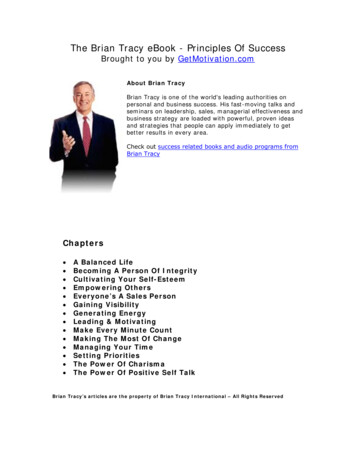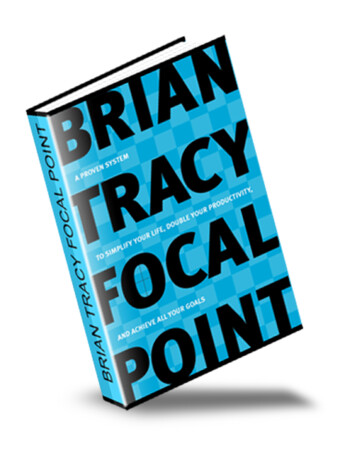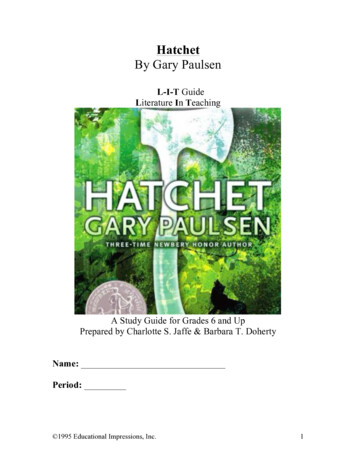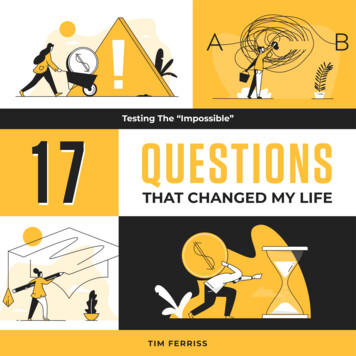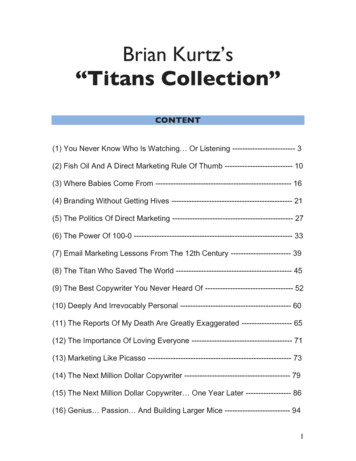
Transcription
Brian Kurtz’s“Titans Collection”CONTENT(1) You Never Know Who Is Watching Or Listening ------------------------- 3(2) Fish Oil And A Direct Marketing Rule Of Thumb --------------------------- 10(3) Where Babies Come From ---- 16(4) Branding Without Getting Hives ------------------------------------------------ 21(5) The Politics Of Direct Marketing ------------------------------------------------ 27(6) The Power Of 100-0 ------------- 33(7) Email Marketing Lessons From The 12th Century ------------------------ 39(8) The Titan Who Saved The World ---------------------------------------------- 45(9) The Best Copywriter You Never Heard Of ----------------------------------- 52(10) Deeply And Irrevocably Personal -------------------------------------------- 60(11) The Reports Of My Death Are Greatly Exaggerated -------------------- 65(12) The Importance Of Loving Everyone ---------------------------------------- 71(13) Marketing Like Picasso ------- 73(14) The Next Million Dollar Copywriter ------------------------------------------ 79(15) The Next Million Dollar Copywriter One Year Later ------------------ 86(16) Genius Passion And Building Larger Mice -------------------------- 941
(17) How Paying Postage Made Me A Better Marketer --------------------- 102(18) The People You Meet On The Way Up ----------------------------------- 110(19) Riffing With Socrates -------- 114(20) The Real Vitamin C And It's Not In Your OJ ------------------------- 116(21) How You Sell Is How You Respond --------------------------------------- 122(22) The Wall With A Door ------- 1292
#1: You Never Know Who isWatching or Listening This subject line seems like a setup to talk about some political conspiracy but it’s not.It’s actually my way of sharing some important “lessons from Mom” we all have tuckedaway somewhere since last Sunday was Mother’s Day and I first shared this story onMother’s Day three years ago.I think the only people in my “online family” reading this stuff back then were bloodrelatives anyway and I’m not sure their open rate was all that high so let’s considerthis post brand new!And the lessons are eternal.One constant over the last three years is that my Mom’s computer was not plugged inthen or now.But even though my Mom will probably never get to read this, I will prove to youthrough today’s recollection that we should listen to our Moms when they say things like:“Treat everyone like you would want to be treated”“Always give of yourself first and don’t be selfish”“Be a mensch.”And if you will allow me, this week’s post is dedicated to my Mom who turned 92 earlierthis month.3
However, another inspiration for this post is from the Titans Mastermind meeting I justheld this past week it was incredible and today’s key lesson was originally triggeredby one of our guest speakers, someone you may have heard of before and if you havenot, you need to know about him.First, a little more setup In past blogs I have spoken about one of the greatest events ever, “The Bencivenga 100,”which was the high bar that was set for “Titans of Direct Response” in 2014.And before “The Bencivenga 100” there was another powerful event I attended inJanuary of 2000 which is where today’s story originates.That event in 2000 was hosted by one of my mentors, Jay Abraham–and it took placeright after what was supposed to be the end of the world according to many I rememberreading the promotion for it from my bunker anticipating the end of the world inDecember of 1999.I came away with three big lessons from that event:1. The world did not end on December 31st 1999 and the Internet caught on AND 2. The internet really did catch on AND 4
3. Always be consistent and congruent in all you do, all the time (see subject line)On January 1, 2000 my clock and computer still continued to work (miraculously) andlater that month I traveled to Los Angeles for Jay’s “all superstar event” dedicated tosome new marketing medium called “The Internet.”Jay–along with fellow rock stars Audri and Jim Lanford–created an event like no other atthe time called the: “Billion Dollar Internet Strategy Setting Summit”Not a very big promise but sounds kind of interesting, doesn’t it?A friend was able to find the link to the promotion and you can take a look at it here.I made some lifelong friends at that event who also became important people that I’vefollowed and learned a ton from over the years including:Audri and Jim Lanford, Paul Hartunian, Dana Blankenhorn, Jim Sterne, CoreyRudl and of course Jay Abraham who was one of my earliest mentors from the 1980’sand I still consider him one today.And unbeknownst to me, there were people watching me back then I wasn’t even awareof future superstars who became life changing to me much later But before I get to that part of story, I wanted to share a quick takeaway from one of thespeakers, Paul Hartunian, which has been with me every day since that conference in2000 and I have to share it with you:“Money doesn’t buy you happiness; money buys you freedom and freedom buys youhappiness.”Just to show you how early in the online game we were then, Paul delivered this quote ina speech about how to make a living as a seller on eBay from your RV traveling thecountry just giving some context to some of my younger readers.Another lesson from that event came almost 13 years later in the form of a LinkedInrequest, out of the blue, from a guy by the name of Jeff Walker.5
If you don’t know Jeff you may know his product, “Product Launch Formula” (PLF)–which at the time I first shared this story 3 years ago, was responsible for over half abillion dollars in online sales of products and services.He’s on version 4.0 of PLF. He’s a marketing genius and one of the real good guys in thisbusiness he’s got a heart of gold to go along with being a “marketing badass” (and tome, “badass” is at the top of the marketing food chain).I don’t believe it is hyperbole to say that PLF is now responsible for over 1 Billion insales of products and services online.Jeff also wrote a New York Times bestseller, Launch, which should be part of everymarketer’s library. I was proud to give it away at my Titans event in 2014 and I gave itaway last week to Titans Mastermind members.Jeff is a hero to thousands of entrepreneurs worldwide genuine and giving to everyone.But if not for the “Abraham-Lanford event” (and my philosophy for how I respond toLinkedIn requests which is outlined here), Jeff would have simply remained just onemore amazing person I looked up to in this fantastic industry My response to the LinkedIn request from Jeff: “Is this THE Jeff Walker?”And to my surprise, I received a response back from Jeff saying he had followed mycareer for many years and he was a fan imagine that Who knew?I surely didn’t.And where did Jeff initially meet me?I had known of him for many years but at the time of his Linked In request I can’t say weever truly “connected” so when I asked him, he told me this story:6
He scraped and clawed his way to Los Angeles to the event in 2000 I described earlier(and he also told me he had no idea how he even was able to pay for it) to learn forhimself how to create a billion dollar Internet strategy.Or I guess that was the reason but looking back on that now, he is one person whoactually accomplished that!He said he watched me moderate a roundtable discussion on something at thatevent and was impressed.He couldn’t believe how much I was sharing without any expectation of anything inreturn, since I was a paid attendee, and not technically a speaker.This certainly sounded like something I’d do but I had little or no recollection of it at all.I also told him that he clearly must not have known much at the time since he was soimpressed!And thankfully it wasn’t simply dumb luck that I was on my “best behavior” when Jeffwas observing me.This re-connection to Jeff on LinkedIn (yes, social media being used for good and notevil!) led to Jeff inviting me as a guest to his “Platinum Plus Mastermind Group” inJanuary of 2013 where I met and interacted with 30 of the most successful folks in Jeff’stribe and I fell in love with all of them.They all just gave and gave and still give and give Jeff attracts the best of the bestmarketers with the biggest hearts.In addition, despite most of them being a lot younger than me, they knew as much ormore about direct response marketing (and how it drives all marketing regardless ofchannel) than I did and I probably had 20 years more “experience” than most of them.I was by no means the smartest person in the room so I knew I was in the right room.Remember:7
“If you are the smartest person in the room you are in the wrong room”My experience in Jeff’s mastermind led to me to joining the group as a paying memberand I have never looked back.Being a member has been equivalent to studying for my PhD in online marketing (andentrepreneurship).I’m thinking I will have my degree in a few decades I have also made friends for life in that group, many of whom are like family to me now.Fast forward to this past week when Jeff came to my Titans Mastermind as a guestspeaker and shared his knowledge and expertise for hours and participated for 2 days,interacting with the group that I have formed and which is, in many ways, inspired bywatching him run his Platinum Plus Group.The lesson is obvious.I decided well before 2000 (especially because I thought the end of the world might benear) that my life was 100% about contribution and connection and by stayingconsistent to that philosophy then (and now), people noticed then (and now).I’m reminded of a wonderful quote from Winston Churchill:“We make a living by what we get, but we make a life by what we give.”And the purpose of sharing all of this with you today is not to brag or pat myself on theback it’s about the importance of being true to yourself, always being congruent, andnever having to talk about “being authentic” because your authenticity is a given.Be scared very scared when you hear people teaching and preaching about “beingauthentic” it’s really not something you can “learn.”It’s simply you being you all the time without ever thinking about it.Tip of the week (and for the rest of your life):8
Keep giving. Never stop giving. And if you have to think about “being authentic” orbeing the same person in your “front stage life” as your “backstage life,” please re-thinkthat very carefully.It pays to be the same person all the time because you never know who is watching Warmly,Brian9
#2: Fish Oil and a DirectMarketing Rule of Thumb I recently asked a doctor who is not a true believer in taking nutritional supplements thisquestion:Is there ONE vitamin or supplement that you could recommend to your patients that youfeel has no downside but also has clear upside for most people?He replied, like many others have (including skeptics), that the ONE he wouldrecommend to almost everyone is fish oil the best source of Omega 3’s and asupplement with more scientific data than most to back up many of the claims regardinghow it makes us healthier.Of course he excluded people who are allergic to fish or soy and I am not going to giveyou all the exceptions we will leave that to the folks who sell the stuff But this idea of the “one thing above all” got me thinking about direct marketing asmost things do and how we can all be super healthy with all of our marketing efforts.I asked this question out loud:What is the ONE fundamental every marketer needs to know, regardless of the mediumthey work in, that is “the fish oil of direct response?”That is, what is that one thing that everyone can apply to everything they do when sellingor marketing any product or service that will steer them most powerfully to their bestcustomers, now and in the future?And it came down to three simple letters:RFM10
I wanted to talk about RFM today to make sure everyone in my online familyunderstands that this “vitamin” is the one everyone needs to take digest and unlikefish oil, there is no chance of an aftertaste and there is no chance that you will ever beallergic to it.If you know all about RFM already, you can stick around for a refresher on the mostimportant principle in direct marketing (in addition to its kissing cousin “Lifetime Value”which we can talk about another day).I’ve been shocked how many people practicing direct response marketing today are noteven aware of the term–or that analyzing RFM on their customer list might be the mostcritical and basic thing to do over all else.While at its most sophisticated level on multi-million name databases you may need astatistician figuring out RFM formulas and models for you, it’s actually a pretty simpleconcept accessible to anyone–and much of it can be done by observation and “tallying”(or tagging) your prospects and customers this way.Let’s break it down:1) “R” is for Recency:What this says is that a suspect/prospect/customer who interacted with you more recentlyis far more responsive (and immediately more valuable) than someone who respondedless recently.I remember when I entered the direct marketing industry in 1981 how much this didn’tmake sense to me logically thinking that if someone just bought from me, they now hadless money to buy something else from me right away.I even remember an old time legacy publisher who did not rent their mailing list of bookbuyers to other mailers offering books because they foolishly thought that, “every personhas a set budget to spend on books per year and we only want them to spend with us.”I guess it’s no surprise that this company is no longer in business, failing to understandthat no one has unique names, only unique lists and also failing to understand that all11
boats rise when we keep the folks on our list active and happy with all kinds of relevantofferings.Thank goodness I discovered how naïve I was within days of entering the world of directresponse and that I didn’t fall into the trap that many others did at the time.It still astounds me when I think about the companies who considered themselves directmarketers back then didn’t understand the power of recency.Fortunately, most marketers today know the importance and value of recency whenhave you NOT received a pop up or immediate cross-sell (or up-sell) offer immediatelyafter buying (or even inquiring) about something online?In direct mail, the names of more recent buyers are called “hotlines”–and list owners stillcharge a premium for those names.I have been lucky that I have been able to see firsthand–over decades of mailing millionsof names and almost always selecting hotlines on lists–that is more often than not themake-or-break whether a list pays out.The importance of recency should never be lost.And this is as true today as it was in the past.2) “F” is for Frequency:Man cannot live on recency alone Frequency pushes us to combine the most recent buyers (or inquiries) with the mostfrequent buyers or inquiries (what we called “multibuyers” in the direct mail listbusiness).Recency and frequency gives you a one-two punch that will enable you to segment anylist, no matter what the size, in order to focus on the people who will be your bestcustomers for subsequent products or offerings.Again, for many of you, I know this sounds basic.12
Of course someone who bought from you multiple times is a better customer thansomeone who bought from you once or never right?But let me add creative and copy into the mix here:Are you communicating with a “multibuyer” with different language based on theirrelationship with you as opposed to communicating with them as a one-time buyer orinquiry (for example)?Or are you sending the same message to the “3 time buyer who bought their third productfrom you today” that you are also sending to the “one time buyer from 6 months ago?”The first group is “family” the second group are invited “guests.”And there are even cases where frequency trumps recency based on the directmarketing rule of thumb that your “expires” (or previous customers or buyers) are usuallyyour “best list.”Example: If you had a subscriber to a publication who renewed multiple times and thenstopped subscribing 6 months ago, mailing them again with messaging that speaks tothem like “family” (e.g. “We want you back!”) rather than messaging that speaks to themas a “guest” (i.e. like any other new prospect), you are clearly missing a hugeopportunity. And this would apply if they stopped subscribing a year ago or more.While recency of when they expired is still important to know and select by, I have hadexperiences in my career where I was able to mail expires who have not been active for 3or more years and we could still revive them–and make them active again–by knowingtheir real value as previous, frequent customers.I know most of you know this instinctively however, I have consulted with too manymarketers and heard too many horror stories from folks who use “one-size-fits-all copy”to all segments of their audience; and even something as simple as “we want you back” toa segment of frequent, former customers (who may not even be recent) can double yourresponse rate or even more. I’ve seen that happen.13
They know you know them already you know them much better than you might beacknowledging and you also (I hope) once loved them.Why would you want to hide that?3) “M” is for monetary value:Now round out this RFM formula by making sure you know the total amount of moneyevery person on your list has spent with you and create “tiers” that make the most sensebased on the price point(s) of your products.The amount of money spent by each customer, in isolation, can be deceivinghowever but combine it with recency and frequency and you will see the power ofsegmenting your list in this very basic way.And making sure you don’t have “one size fits all promotion” as I mentioned before(emails, letters, anything) and that you talk to your customers based on theirrelationship with you all “calculated” through RFM can be a game changer.I want to share a quick story to bring this home:I have a friend/client who has 18 different products and she does an incredible job crossselling and upselling to her existing customers the products they have not boughtpreviously.But when I saw a breakout of her buyer list, something like 80% or more of the folks hadonly bought one product while most of the others had bought 2 or 3 at most and itseemed that with some “RFM segmenting tweaks” there was huge potential to get moreof those “1 to 3 time buyers” to buy much more given all of the related offeringsavailable.We got religion on this when I noted that there was ONE person on the list who boughtALL 18 products (and no, it was not a relative!) and I asked the question:“When did you invite this 18 time buyer to dinner?”Of course I was being a little sarcastic but I was also trying to make an important point.14
Yes ”lists are people too!”From that question we started surveying the most recent, frequent and high dollarspending customers, finding out why they bought multiple products and also in whatorder they bought them to look for trends in buying behavior.That led to what I call a logical (and much more successful) “contact strategy” where westarted offering products to previous buyers in a sequence that made more sense thansimply making random offerings.This strategy was rooted in addressing the needs and buying patterns of existingcustomers and of course with copy and creative that spoke to why their recent purchaseleads perfectly to the next purchase with customized copy to different segments.I am only scratching the surface how something as basic and fundamental as RFM canchange your entire marketing strategy in terms of which offers to offer when–and how tospeak to different segments of your family when making those more targeted offers.I admit that talking about RFM in a little less than 2,000 words doesn’t do it justice butI needed to get this out there just in case there is even one person in my online familywho doesn’t look at RFM as the most important, basic segmenting tool at their disposal.It’s the one thing that always needs to be in play when doing any kind of direct responsemarketing.However, that doesn’t mean you should forget to take your fish oil either.Warmly,Brian15
#3: Where Babies ComeFrom I’ve been thinking about “original source” a lot this week with the release of the “TitansMarketing edition” of Breakthrough Advertising by Gene Schwartz.Gene was one of many “originals” who paved the way for everything we do today inmarketing, copywriting and the study of human behavior. And as mentioned above, Geneis the man responsible for the most important book ever written for marketers andcopywriters, Breakthrough Advertising, which is now available to everyone.Why is knowing the original source of things so important?Why do we need to look at the past in order to create a bigger future?The reason is summed up in the Picasso quote (which I have shared with you multipletimes in the past):“Learn the rules like a pro so you can break them like an artist.”Gene Schwartz in particular is one of those pros who, because he learned all of “therules” first, became one of the most prolific “artists” in so many areas of his life.I talk about that in detail in the afterword in the new edition of Breakthrough Advertising.And now we can all pay it forward by learning the rules from him; and then making it ourgoal to become the next generation of artists.I know Gene is smiling down on us right now since he was as much a teacher as he wasan artist.Inspired by those thoughts of Gene’s smile (he had a magical one), I began to think moreabout this idea of “original source” or what I am calling today, “where babies comefrom.”16
I recalled the interview I did with one of the smartest and most insightful marketersactive today, Perry Marshall, talked about this idea in detail.Perry’s track record of successes–based on his application of this principle in everythinghe does–makes him the perfect person to bring into this conversation.This interview was released last year but given its relevancy to the new editionof Breakthrough Advertising, I wanted to send it to you again today.But before I do that, I want to talk more about this critical concept.Perry called the interview, “6 Dead Guys and One Marketing Legend” referring to mynew book at the time, The Advertising Solution) but for today’s purposes, I like myupdated subject line about where babies come from much better: I finally realized that itwas NOT “the stork” who brought us direct marketing fundamentals.Hopefully your Mom or Dad told you that as well.I think this interview is a must listen for anyone who plans on being a world classmarketer over the next 50 years.Of course I am not objective More background about today’s interview:Hopefully you know by now that my new book (which is not so new anymore!) profiles 6of the most legendary advertising men of all time all no longer with us and allpioneers of everything we consider sacred in direct marketing today.I guess you would define them as some of the original “Mad Men” (i.e. the most prolificgeneral advertising minds of their eras).However, I believe they were all actually direct marketers trapped in the bodies ofgeneral advertisers.What I have learned by diving into their work, thanks to my amazing co-author CraigSimpson, has been game changing for me–and the thousands who have already read it.17
I hope you will buy it, read it and also grab all of the free bonuses at:TheLegendsBook.com.“Rules from pros.”Back to Perry:He wrote a blurb for the book, calling it “the make sure we don’t miss anythingchecklist.”That gave me an idea:I would have Perry interview me for his list maybe sell a few books and then in thatinterview, talk about what he is currently involved in with the incredible Richard Kochand HIS new book, Simplify.This was inspired by the fact that I kept seeing Richard’s new book popping up onAmazon next to mine.I told Perry that we also needed to talk about how The AdvertisingSolution and Simplify overlapped but then something else happened.The surprise element that came up during the interview was a discussion of theimportance of knowing the “original source” of the techniques we use and deploy today.The punch line:Knowing those fundamentals where they came from and how they were “invented” makes us better at everything we do today and not simply to take a stroll down memorylane.Case in point:I was on a podcast not long ago and the interviewer decided to take a deep dive into thetopic of “regression modeling.”18
This is the technique used to statistically predict response rates before mailing names(using direct mail) on large databases and individual lists, sometimes modeling millionsof names at a time with incredibly predictable results.It’s a technique I used throughout my career (with the help of a top notch statisticiansince I was an English Major in college!) and a technique that has been around a verylong time yes, even before the Internet!And it still works.Imagine that.I was surprised the interviewer decided to go down this path in our discussion since I wasgetting the sense we were getting a bit granular for his audience and I was afraid wewould lose them.But it was an interesting discussion and a topic so few people in the online world todayever ask me about so I went with the flow and then he posted the interview onFacebook.One of the responses was both flattering and telling:“Wow! This interview with Brian Kurtz is fantastic. In it he talks about this incrediblemodeling technique he used earlier in his career. And I thought Facebook inventedlookalike models. Mind blown!”I am not sharing this with you to make light of anything or anyone but it illustrates animportant point.That is, having a deep understanding of the modeling techniques that came before(including “lookalike models” which are far less predictable than “regression models,” atopic for another day) can only make you better as you buy ads from models created onFacebook.19
Knowing “where babies (i.e. modeling on lists) comes from” will enable you to askdifferent (and more probing) questions of your Facebook agency/media buyer (using thisexample); and it will lead to ideas you never would have thought possible.And I have to tell you, stuff like this happens every day with my own clients and withsome of the greatest online marketers I know and love.We regularly see examples where having a historical perspective on fundamentals ofdirect marketing will always lead to new insights (and higher levels of success) using acurrent, state-of-the-art technique.So below is the interview with Perry which talks about this concept and much more.I am sharing it today in honor of Gene Schwartz–and to serve as a reminder the power of,and never forgetting, the value of re-learning the fundamentals–and everything that got usto where we are today.I regularly say that this is absolutely the best time in the history of the world to be amarketer and having as much knowledge and information of what has worked in thepast will only make you bigger and stronger using the incredibly effective tools andmethodologies being developed every day many through advanced technology, manythrough advanced logic, but ALL based on direct marketing principles of the past.The interview with PerryWarmly,Brian20
#4: Branding Without GettingHives I will make the assumption that if you are part of my online family you are “one ofus” a serial direct marketer and marketing terms like “branding,” “public relations,”and “publicity” give us the creeps, right?Our favorite question:“How are you going to measure THAT?”I recall a case of those “creeps” turning into a case of hives early in my career when anadvertising sales guy suggested I try some advertising for “brand recognition.”My response:“If you can’t guarantee me a Nike swoosh, I’m not interested.”The hives then disappeared as did the agency guy However, I have become somewhat of a hypocrite over the years.While recalling some specific case histories and successes of the past and present, there isa version of “branding” that can be incorporated into a strict direct marketingenvironment one where measurement and return on investment on every media buy isparamount.Having said that, I am not going to work on Madison Avenue anytime soon for a generaladvertising agency nor do I yearn to be one of the “Mad Men” who lived in a world of,“If the advertising looks good and it is catchy, it must be working.”The story that I want to share with you this week is about a major breakthrough at myformer company Boardroom that could be traced to a “new branding strategy”–and I21
realized I carry this one with me in all I am involved with today when it comes tobranding without getting hives The reason I find this story so educational (and applicable today) is because while it has a“branding” component to it, it also teaches to never throwadvertising/marketing/promotion dollars at anything without an expected, measurablereturn and I hope you find the lesson valuable.Hint: Messaging and how that messaging relates to list makeup/segmentation played ahuge role.I guess that comes as no surprise.Boardroom Inc. was launched in 1972 with a newsletter called Boardroom Reports whichtaught small business people how to run their businesses better it was a publication allabout the practical and useful and subscriptions were sold almost exclusively throughdirect mail.In 1980, the company launched a newsletter called Bottom Line/Personal (BLP) whichessentially appealed to the “consumer side” of that same executive who subscribedto B
Audri and Jim Lanford, Paul Hartunian, Dana Blankenhorn, Jim Sterne, Corey Rudl and of course Jay Abraham who was one of my earliest mentors from the 1980’s and I still consider him one today. And unbeknownst to me, there were people watching me back then I wasn’t even aware of


